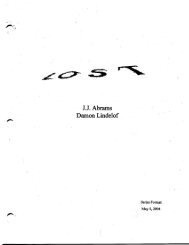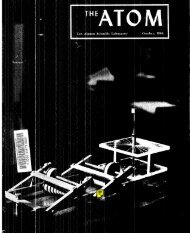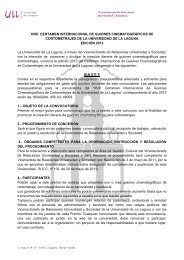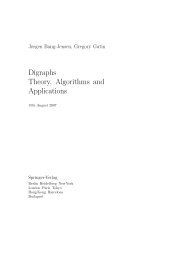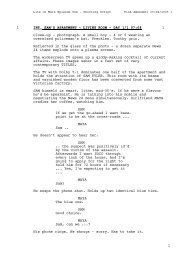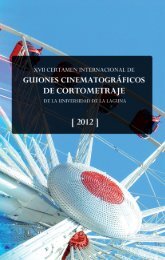Create successful ePaper yourself
Turn your PDF publications into a flip-book with our unique Google optimized e-Paper software.
PHYSICS<br />
CONTEST<br />
[Ulil'rorlull ol ulatop<br />
"The empty mirror. lf you could really understand that,<br />
there would be nothing left to look fs1'."-ysn de Wetering<br />
by Arthur Eisenkraft and Larry D. Kirkpatrick<br />
N I L'. ,?ff,il1#'#,fJl;<br />
I -asic<br />
shows and see the ma-<br />
I gicirtt push sharp swords<br />
through a box containing the<br />
"lovely assistant" or ride the<br />
"Haunted Mansion" and see the<br />
ghost flying through the room at<br />
Disneyland/ we are often surprised<br />
and pleased by clever manipulations<br />
of images.<br />
In this contest problem, we'll<br />
look at the image producedby a concave<br />
mirror filled with water. Because<br />
our con{idence in a physics solution<br />
increases if different<br />
approaches to the problem yield the<br />
same result and there are many<br />
ways of obtaining the position of the<br />
image, we will want to discover as<br />
many of them as possible. Perhaps<br />
you will come up with a solution<br />
that is fundamentally different from<br />
the ones we expect.<br />
Texts on geometrical optics often<br />
begin by showing that the reflection<br />
of light from plane mirrors follows<br />
the principle that the angle of incidence<br />
is equal to the angle of reflection.<br />
If the mirror is curved, this behavior<br />
still holds, but the geometry<br />
of the parabolic mirror is such that<br />
all parallel rays come to a focus for<br />
a concave mirror, or appear to diverge<br />
from the focus in the case of a<br />
convex mirror. For a spherical mirror,<br />
the spherical surface approximates<br />
the parabolic curve and parallel<br />
rays near the axis also come together<br />
at (or diverge from) the focus.<br />
The relationship between the<br />
image and object is given by the<br />
mirror formula<br />
111<br />
s s' f'<br />
where s and s'are the distances of<br />
the object and image from the surface<br />
of the mirror and I is the focal<br />
length of the mirror. The focal<br />
length is often stamped on the mirror<br />
and is equal to one half of the<br />
radius of the spherical surface from<br />
which the mirror is made. The focal<br />
length can be measured by shining<br />
a beam of parallel light onto a concave<br />
mirror and measuring the distance<br />
from the surface of the mirror<br />
to the point where the beam is<br />
brought to a focus. For a convex<br />
mirror the light appears to diverge<br />
from a focal point located behind the<br />
mirror. Both of these points can be<br />
determined by drawing several rays<br />
parallel to the axis of the mirror, using<br />
the law of reflection at the surface,<br />
and locating where the rays<br />
CIOSS.<br />
To make effective use of the mirror<br />
formula we must remind ourselves<br />
of a number of conventions.<br />
The fistance s is positive if the object<br />
is located in front of the mirror.<br />
This will always be the case for real<br />
objects, but the "obiect" couldbe an<br />
image produced by another optical<br />
device. I:r this case, the object could<br />
be located behind the mirror and s<br />
would be negative. If the image is<br />
located in front of the mirror, the<br />
image distance s'is positive; if the<br />
image is behind the mirror, s' is<br />
negative. Finaily, f is positive for a<br />
concave mirror and negative for a<br />
convex mirror.<br />
As an example, consider an object<br />
located a distance 3/ in front of a<br />
concave mirror:<br />
1 r 1 I 1.2^ -=-:<br />
-=---=--_ s'fsf33<br />
Therefore, the image is located a<br />
distance 3f 12 in front of the mirror.<br />
This can also be shown with a diagram<br />
that traces the rays. Convince<br />
yourself that the image would be<br />
3f l4behind the mirror if we use a<br />
convex mirror instead of the concave<br />
mirror.<br />
The mirror formula also works<br />
for lenses if we adopt the following<br />
conventions: s is positive if the object<br />
is located in front of the lens,<br />
negative if the obfect is located behind<br />
the lens; s' is positive if the<br />
image is located behind the lens,<br />
Y<br />
f,<br />
m<br />
cl)<br />
(d<br />
E<br />
o<br />
F<br />
_o<br />
!2 JU[Y/rtlEtlsI tss4



